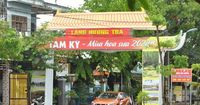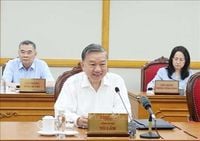The People's Council of Tam Ky City has approved the policy of establishing four wards in the city according to the directive on rearranging commune-level administrative units. This decision comes as part of a broader initiative to streamline local governance and enhance administrative efficiency.
According to reports, the new wards will merge twelve existing communes and wards into four new commune-level administrative units. The newly established wards include Tam Ky (which merges An My, An Xuan, and Truong Xuan wards), Ban Thach (merging Tan Thanh and Hoa Thuan wards, along with Tam Thang commune), Quang Phu (comprising An Phu ward and Tam Thanh, Tam Phu communes), and Huong Tra (which combines Hoa Huong, An Son wards, and Tam Ngoc commune).
Local residents have expressed strong support for the merger, with over 98% of surveyed voters approving the consolidation of these administrative units. Mr. Phan Cong Ba, a resident of An Xuan ward, stated, "I completely support this measure as it presents a favorable opportunity for local development in the new context. The size of each ward is quite small, so the merger is not surprising. The new names for the wards reflect our historical and cultural traditions, making it a sensible decision. For example, naming the new ward Tam Ky is appropriate since it has been the core area of Tam Ky for a long time."
The administrative changes will result in the new Tam Ky ward having a population of over 44,000 people and an area of 8.3 km², with its working headquarters expected to be located in An My ward. Ban Thach ward will house approximately 36,800 residents over 34.7 km², with its headquarters planned for Tan Thanh ward. Quang Phu will accommodate over 28,800 people across 36.2 km², while Huong Tra will have a population of more than 33,500 and an area of 14.6 km², with its headquarters set in An Son ward.
Historically, Tam Ky has a rich cultural background, having been established as a district in 1471 during the reign of King Le Thanh Tong. It transformed into a political and administrative center in 1997 and became a city in 2006. The city has continually evolved, asserting itself as a second-tier urban center and a vital political, economic, and cultural hub for Quang Nam province.
Mrs. Dang Thi Phu Hoa, Chair of the Legal Committee of the People's Council of Tam Ky, emphasized that the new administrative units would ensure smooth governance and align with the historical and cultural context of the region. She noted, "The new administrative units are designed to be cohesive, facilitating effective state management and promoting social and economic development. The adjustments reflect the historical and cultural significance of the residents, which is crucial for the future growth of our community."
Mr. Pham Hoang Duc, Deputy Secretary of the Tam Ky Municipal Party Committee and Chairman of the People's Council, shared his perspective on the historical significance of the name "Tam Ky." He stated, "For generations, Tam Ky has been a land rich in history and culture. The name has become a symbol, intertwined with the ups and downs of Quang Nam’s landscape. Given the practical demands of development and the overarching directives from the Party and State regarding administrative restructuring, this merger is a necessary step toward modernization and sustainable development."
As part of the restructuring process, local authorities have conducted thorough evaluations of the existing administrative units, ensuring that the merger aligns with scientific and systematic procedures. They have actively sought public input, demonstrating a commitment to democratic values and transparency.
Despite the challenges associated with reorganizing administrative units, including potential concerns from residents and staff, officials are optimistic about the benefits of the new structure. Mr. Duc acknowledged the difficulties, stating, "While we anticipate challenges in reorganizing the administrative apparatus and addressing the sentiments of the people and civil servants, we recognize that merging these administrative units is a historically significant decision. It is not merely about combining geographic boundaries but expanding development opportunities and modernizing our political system to keep pace with new trends."
In related news, the 9th session of the 15th National Assembly opened in Hanoi on May 5, 2025. This mid-year session is longer than usual and will address several critical issues. The Steering Committee for the rearrangement of commune-level administrative units in Nghe An province has encouraged localities to reevaluate the naming of administrative units post-rearrangement, avoiding the use of district-level names with ordinal numbers.
On April 28, during a visit to Vietnam, Thongloun Sisoulith, General Secretary of the Lao People's Revolutionary Party and President of Laos, led a high-level delegation to pay respects to President Ho Chi Minh. This visit underscores the enduring ties between Vietnam and Laos, rooted in shared history and mutual respect.
The restructuring of local administrative units is not unique to Tam Ky or Nghe An. In Soc Trang province, for example, the number of commune-level administrative units is set to decrease from 108 to 43, a reduction of 65 units. This includes the establishment of new wards and communes through the merging of existing units, reflecting a nationwide trend aimed at enhancing administrative efficiency and governance.
As these changes unfold across various provinces, they highlight the Vietnamese government's commitment to modernizing its administrative structures while honoring the historical and cultural contexts of its communities. The successful implementation of these reforms will depend on continued public support and effective management from local authorities.





